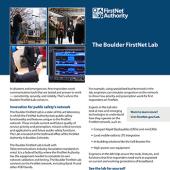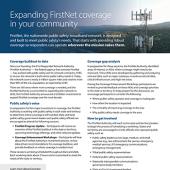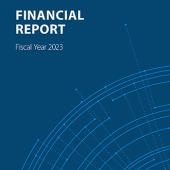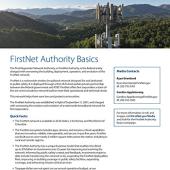This blog is a repost from MissionCritical Communications, originally published on October 22, 2019. The original article can be accessed here.
First Responder Network Authority (FirstNet) officials participated in the Sept. 16 – 20 Third Generation Partnership Project (3GPP) meetings in Newport Beach, California. Several features important to critical communications users advanced in the standards process.
More than 300 delegates representing vendors, operators and government agencies from around the globe participated in the Radio Access Network (RAN) plenary meeting. During this meeting, a new work item for Release 16 5G new radio (NR) vehicle to anything (V2X) was approved. This work will specify radio solutions that are necessary for NR to support advanced V2X services and will also support direct mode communications for public-safety use.
The 5G work item and Long Term Evolution (LTE) had overall progress on all study and work items, which included enhanced machine type communications (eMTC), narrowband internet of things (NB-IoT), industrial IoT (IIoT), user equipment (UE) power savings and enhanced ultrareliable low latency communications. These accomplishments were possible because of tightly scheduled online discussions and carefully organized offline sessions.
The third day of the plenary was a joint meeting between the RAN and Systems and Services Aspects (SA) plenary delegates. The joint meeting’s objective was to prioritize topics of mutual interest for Release 17 between the technical specification groups (TSGs) and identify the interaction and dependencies between RAN and SA. Several SA work items related to Release 17 that had RAN impact and are of interest to public safety include enhancements for unmanned aerial systems (UAS), support for multi-universal subscriber identity module (USIM) devices and enhanced relays. The joint meeting helped RAN working groups become aware of areas where more interaction is required with SA working groups.
After the joint session, the RAN meeting continued with prioritization of topics that included additional Release 17 5G NR V2X sidelink enhancements, a topic of interest to FirstNet. The term sidelink is commonly used in RAN for direct mode communications. The enhancements identified include increased data rate, improved reliability, reduced latency, support of new carrier frequencies and operational scenarios, UE power savings, better spectral efficiency and improved coverage.
Another topic of interest is a study on support for nonterrestrial networks (NTN) — satellites — in the 3GPP specifications. The immediate focus includes defining the necessary 5G features to support NTN solutions. The initial plan is for NTN to be natively integrated into 3GPP specifications, with resulting benefits from technology commonalities with currently defined 3GPP wireless systems.
FirstNet’s standards team will participate in the continuing discussion of Release 17 planning during the coming months with the objective to finalize the planning during the next plenary in December.
The Core Network and Terminals (CT) plenary meeting included about 150 delegates. The CT work covers the protocol details and follows the architectural work performed in the SA working groups. The primary focus was on approval of Release 16 work.
During this plenary, FirstNet presented the status of stage three specifications “Mission Critical Push To Talk (MCPTT) call control interworking with LMR systems” (TS 29.379) and “MCPTT media plane control interworking with LMR systems” (TS 29.380) on behalf of the rapporteur and pointed out the significant progress for those two specifications. FirstNet said the two technical specifications have reached a stable status and can be the basis for initial implementation of interworking products, with add-on features included in future versions. FirstNet expects formal approval for the two specifications at the next plenary in December.
Another item of interest is the new approved work item for extension of multicast broadcast for mission-critical services. This work will extend the ability to broadcast critical files to multiple first responders involved in an incident. Also, work on enhancements to over-the-air (OTA) device configuration that might provide some extra capabilities for public safety has begun. FirstNet will track these Release 17 work items.
The SA plenary meeting included more than 200 delegates with a significant amount of time spent on Release 17 planning and work prioritization because SA working group 2 (SA2) determined that it is overloaded with the current scope of the proposed work items for Release 17.
FirstNet, with the support of AT&T and a number of agencies of other governments, provided a view of the top priority features for public safety. It is important to note that two features critical to public safety, proximity services (direct mode) and multicast broadcast over 5G, received significant support and were agreed to be included in Release 17. There will be follow-up discussions in the next SA plenary meeting to prioritize the scope for all of the work items that are agreed for inclusion in Release 17. The scope prioritization will also take into account RAN working groups’ abilities to complete the work in Release 17.
Stage 1 Release 17 requirements are 80% complete with full completion expected by the end of this year. Stage 2 Release 16 architectural work is greater than 90% complete. Release 17 stage 2 work is about to begin based on Stage 1 requirements.
Other items of interest that advanced to SA plenary approval status include:
Stage 1 – Requirements
- The study on communications service requirements for critical medical applications (CMED) requirements (Release 17). Follow-on normative specification work is 80% completed.
- The study on enhanced relays for energy efficiency and extensive coverage that support a multihop relay, a possible key feature for public safety (Release 17). Follow-on normative specification work is 90% completed.
- The study on support for minimization of service interruption (Release 17). Follow-on normative specification work is 80% completed.
- The approval of a new study on sharing administrative configuration between interconnected mission-critical services (MCS) systems (Release 18).
Stage 2 – Architecture
- Architecture enhancements for 3GPP support of advanced V2X services (Release 16)
- Enhanced mission-critical data (MCData), including architecture changes for emergency and imminent peril operation
- Enhanced interworking with legacy LMR (additional feature support and other enhancements)
- A new study on MCS over 5G multicast-broadcast was approved (Release 17)




















